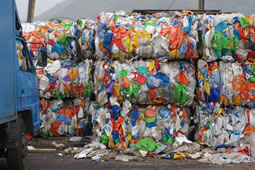Consumption of plastic in Germany continues to increase. The issue of waste utilisation in Germany has been clarified: more than 96 per cent of plastic waste is now utilised. Consequently, plastics are an important resource even after their first usage phase.
 (01.06.2010) These are the most significant results of the new study entitled Produktion, Verarbeitung und Verwertung von Kunststoffen in Deutschland 2007 (Production, processing and utilisation of plastics in Germany 2007). The recently published study was commissioned by Beteiligungs- und Kunststoffverwertungsgesellschaft mbH (BKV) and PlasticsEurope Deutschland e.V. with the collaboration of important plastics-relevant associations in Germany and was conducted by Consultic Marketing und Industrieberatung for the sixth time.
(01.06.2010) These are the most significant results of the new study entitled Produktion, Verarbeitung und Verwertung von Kunststoffen in Deutschland 2007 (Production, processing and utilisation of plastics in Germany 2007). The recently published study was commissioned by Beteiligungs- und Kunststoffverwertungsgesellschaft mbH (BKV) and PlasticsEurope Deutschland e.V. with the collaboration of important plastics-relevant associations in Germany and was conducted by Consultic Marketing und Industrieberatung for the sixth time. | Copyright: | © Deutscher Fachverlag (DFV) |
| Quelle: | Entsorga China 01_2010 (Juni 2010) |
| Seiten: | 1 |
| Preis: | € 0,00 |
| Autor: | Martin Boeckh |
| Artikel nach Login kostenfrei anzeigen | |
| Artikel weiterempfehlen | |
| Artikel nach Login kommentieren | |
Europäische Rechtsvorgaben und Auswirkungen auf die Bioabfallwirtschaft in Deutschland
© Witzenhausen-Institut für Abfall, Umwelt und Energie GmbH (11/2025)
Bioabfälle machen 34 % der Siedlungsabfälle aus und bilden damit die größte Abfallfraktion im Siedlungsabfall in der EU. Rund 40 Millionen Tonnen Bioabfälle werden jährlich in der EU getrennt gesammelt und in ca. 4.500 Kompostierungs- und Vergärungsanlagen behandelt.
Vom Gärrest zum hochwertigen Gärprodukt - eine Einführung
© Witzenhausen-Institut für Abfall, Umwelt und Energie GmbH (11/2025)
Auch mittel- bis langfristig steht zu erwarten, dass die Kaskade aus anaerober und aerober Behandlung Standard für die Biogutbehandlung sein wird.
Die Mischung macht‘s - Der Gärrestmischer in der Praxis
© Witzenhausen-Institut für Abfall, Umwelt und Energie GmbH (11/2025)
Zur Nachbehandlung von Gärrest aus Bio- und Restabfall entwickelte Eggersmann den Gärrestmischer, der aus Gärresten und Zuschlagstoffen homogene, gut belüftbare Mischungen erzeugt. Damit wird den besonderen Anforderungen der Gärreste mit hohem Wassergehalt begegnet und eine effiziente Kompostierung ermöglicht.